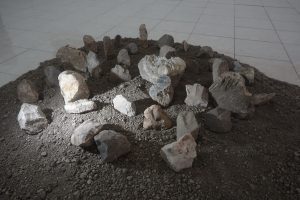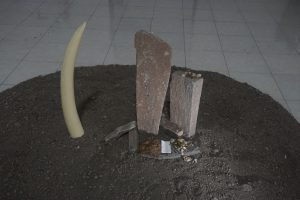The Kahe Maumere Community together with the STFK Ledalero Senate Student were involved in organizing an exhibition titled Re-Imagine Bikon Blewut (R-IBB). As part of the Docking Program of the Biennale Jogja XVI Equator #6, this exhibition was held at the Bikon Blewut museum, which is located in the St. Paul Ledalero high seminary. Taking place from 18 to 24 September 2021, R-IBB succeeded in attracting public attention. Support and appreciation were given by several academics, art activists, traditional leaders, and the community around the city of Maumere.
Bikon Blewut Museum is a cultural site that contains a collection of fossils and ancient human artifacts. The existence of this museum is difficult to separate from the role of the Societas Verbi Divini (SVD) missionaries. The missionaries who became the mastermind behind the establishment of this museum were P. Theodor Verhoeven, SVD, and P. Piet Petu, SVD. Verhoeven, SVD was a Dutch missionary sent by the Rome Generalate in 1949. He stayed at the Mataloko Seminary and was assigned to teach Latin. The assignment was chosen because it was by his interest and love for the world of linguistics, especially classical languages.
However, he is open to learning about the history and local culture. This attitude prompted him to conduct serious and systematic research in several areas in Ngada and Manggarai. He was not alone. With him, his student at the Mataloko Seminary, P. Piet Petu, SVD was also sent. Both were involved in the excavation of paleolithic (old stone), mesolithic (middle stone) and neolithic (young stone) fossils in several areas of the island of Flores.

Susunan Batu di Ruang Pamer (Foto: Bernard Lazar/Dok. Komunitas KAHE)
The excavations yielded several interesting findings, simultaneously shocking the archaeological world. All discoveries were originally stored in the Mataloko Seminary classroom in 1965. They were then transferred to St. Paulus Ledalero High Seminary after P. Verhoeven returned to the Netherlands in 1983. In Ledalero, all fossils and historical artifacts were kept in a special room which was later named Bikon Blewut.
P. Piet hopes that the Bikon Blewut museum can become a pillar for a tradition that has become tilted (bikon) and weathered (blewut). With a strong ethnographic approach, he translated the context and meaning of the artifacts found into the layout of the exhibition space and built a dramaturgical plot based on themes that are continuously updated over a period of time.
 P. Piet’s curatorial work expressly aimed to build the Bikon Blewut museum as a contact zone. He wanted to imitate the patterns of representation that are often found in foreign museums, which in many cases fall on scientism at one pole and exoticism at the other. Meanwhile, for P. Piet, museums must be synchronic as well as diachronic, universal as well as specific.
P. Piet’s curatorial work expressly aimed to build the Bikon Blewut museum as a contact zone. He wanted to imitate the patterns of representation that are often found in foreign museums, which in many cases fall on scientism at one pole and exoticism at the other. Meanwhile, for P. Piet, museums must be synchronic as well as diachronic, universal as well as specific.
Museums are obligated to represent the typical context of artifacts that do not come from a cultural vacuum, as well as build universal discourses and values. Museums must maintain the traditional, local, and contextual values of a cultural entity while continuously making these cultural elements relevant to the community and, especially, their immediate environment.
The question is, how is the current existence of the Bikon Blewut museum? What is the reason for the Re-Imagine Bikon Blewut exhibition?